
Holothuria atra, commonly known as the black sea cucumber or lollyfish, is a species of marine invertebrate in the family Holothuriidae. It was placed in the subgenus Halodeima by Pearson in 1914, making its full scientific name Holothuria (Halodeima) atra. It is the type species of the subgenus.
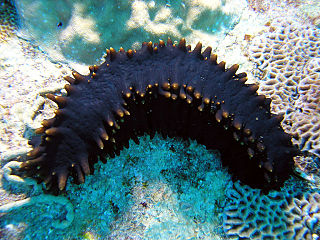
Stichopus chloronotus is a species of sea cucumber. Common names include the greenfish sea cucumber, the spiky sea cucumber and the black knobby sea cucumber. It is native to the Indo-Pacific region. It has a wide range and is abundant and the IUCN lists it as being of "Least Concern".
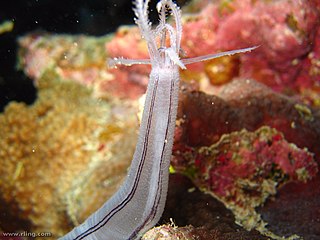
Synaptula lamperti is a species of sea cucumber in the family Synaptidae in the phylum Echinodermata, found on coral reefs in the Indo-Pacific region. The echinoderms are marine invertebrates and include the sea urchins, starfish and sea cucumbers. They are radially symmetric and have a water vascular system that operates by hydrostatic pressure, enabling them to move around by use of many suckers known as tube feet. Sea cucumbers are usually leathery, gherkin-shaped animals with a cluster of short tentacles at one end. They live on the sea bottom.
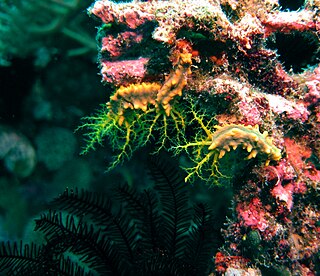
Colochirus quadrangularis, commonly known as the thorny sea cucumber, is a species of sea cucumber in the family Cucumariidae. It is found in shallow seas in tropical parts of the Indo-Pacific region.

Colochirus robustus, commonly known as the robust sea cucumber or the yellow sea cucumber, is a species of sea cucumber in the family Cucumariidae. It is found in shallow seas in tropical parts of the central Indo-Pacific region. C. robustus belongs to the class Holothuroidea, a group of echinoderms called sea cucumbers and known for unusual behavior including evisceration, asexual reproduction, and regeneration. The robust sea cucumber has a soft body and lacks a spine, but it does have an endoskeleton consisting of microscopic spicules, or ossicles, made of calcium carbonate. C. robustus has a respiratory tree that allows it to extract oxygen for respiration, using the anus to pump water. The robust sea cucumber is an important dietary staple for many East and Southeast Asian populations, and has been used for medicinal purposes for hundreds of years. Recent research suggests that peptides from C. robustus enhance the activity of the immune system.

Pearsonothuria is a genus of sea cucumbers in the family Holothuriidae. Pearsonothuria graeffei is the only species in the genus. Graeffe's sea cucumber is found in the tropical Indo-Pacific Ocean and the type locality is Viti Island, Fiji. It is named after Eduard Heinrich Graeffe, Semper's coworker at the Museum Godeffroy.

Holothuria leucospilota, commonly known as the black sea cucumber or black tarzan, is a species of marine invertebrate in the family Holothuriidae. It is placed in the subgenus Mertensiothuria making its full scientific name Holothuria (Mertensiothuria) leucospilota. It is the type species of the subgenus and is found on the seabed in shallow water in the Indo-Pacific.

Holothuria edulis, commonly known as the edible sea cucumber or the pink and black sea cucumber, is a species of echinoderm in the family Holothuriidae. It was placed in the subgenus Halodeima by Pearson in 1914, making its full scientific name Holothuria (Halodeima) edulis. It is found in shallow water in the tropical Indo-Pacific Ocean.

Synapta maculata, the snake sea cucumber, is a species of sea cucumber in the family Synaptidae. It is found in shallow waters in the tropical Indo-Pacific Ocean. Sometimes growing as long as 3 m (10 ft), it is one of the longest sea cucumbers in the world.
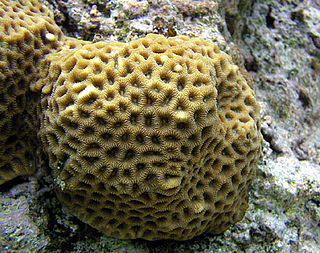
Favites abdita, also known as the larger star coral, is a species of stony coral in the family Merulinidae. It is native to the Indo-Pacific region and its range extends from East Africa and the Red Sea through the Indian Ocean to the Western Pacific Ocean. The International Union for Conservation of Nature has rated its conservation status as being "near-threatened".

Oulophyllia crispa, sometimes called the intermediate valley coral, is a species of stony coral in the family Merulinidae. It is native to the tropical western and central Indo-Pacific region. Although this coral has a wide range, it is generally uncommon and seems to be decreasing in abundance, and the International Union for Conservation of Nature has rated its conservation status as being "near threatened".

Actinopyga echinites, commonly known as the brownfish or deep water redfish, is a species of sea cucumber in the family Holothuriidae. It is native to the tropical Indo-Pacific region and is harvested for food.
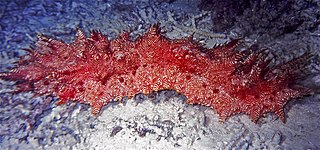
Thelenota rubralineata is a species of sea cucumber in the family Stichopodidae, in the phylum Echinodermata, mainly located in the central Indo-Pacific region. It has a distinctive coloring pattern, and can be found on the seabed near coral. T. rubralineata is a member of the Thelenota genus, characterized by their large size and the presence of a calcareous ring.

Holothuria fuscocinerea, the ashy pink sea cucumber, is a species of sea cucumber in the family Holothuriidae. It is placed in the subgenus Stauropora, making its full name Holothuria (Stauropora) fuscocinerea. It is native to shallow water in the tropical and sub-tropical Indo-Pacific.

Holothuria fuscopunctata, the elephant trunkfish, is a species of sea cucumber in the family Holothuriidae native to shallow water in the tropical Indo-Pacific. It is placed in the subgenus Microthele, making its full name Holothuria (Microthele) fuscopunctata.

Synaptula recta, sometimes known as the gut-like sea cucumber, is a species of sea cucumber in the family Synaptidae in the phylum Echinodermata. It occurs in shallow water in the tropical Indo-Pacific region.

Stichopus herrmanni, or Herrmann's sea cucumber, is a species of holothuroidean echinoderm in the family Stichopodidae. It is found in the tropical, western Indo-Pacific Ocean, at depths down to 20 m (66 ft). This and several other species are known as curryfish and are harvested commercially; it is called gama in Indonesia.

Holothuria hilla is a species of sea cucumber in the subgenus Mertensiothuria of the genus Holothuria. Some common names include the contractile sea cucumber, the sand sifting sea cucumber and the tigertail sea cucumber, and in Hawaii it is known as the light spotted sea cucumber. It is found in the Indo-Pacific region and the Red Sea.

Actinopyga varians, the Pacific white-spotted sea cucumber or Hawaiian sea cucumber, is a species of sea cucumber in the family Holothuriidae. It is found in the Pacific Ocean near Hawaii and also in the Indo-Pacific Ocean.

Holothuria (Thymiosycia) impatiens, commonly known as the impatient sea cucumber or bottleneck sea cucumber, is a species of sea cucumber in the genus Holothuria, subgenus Thymiosycia.





















